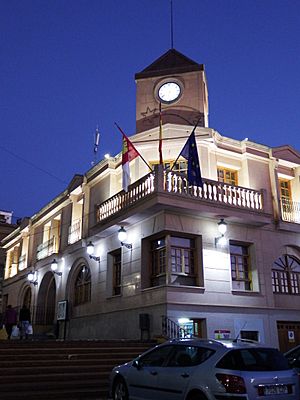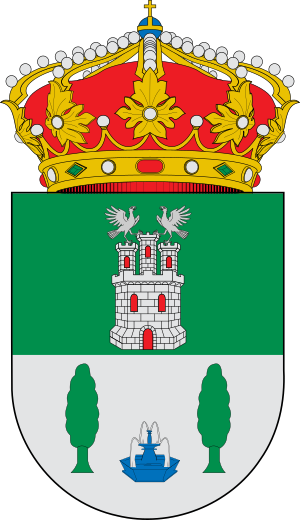Fuente-Álamo facts for kids
Fuente-Álamo is a small town in the Albacete area of Castile-La Mancha, Spain. It's about 61 kilometers (38 miles) from the main city of Albacete. In 2011, about 2,639 people lived there.
Contents
What's in a Name?
The name Fuente-Álamo means "poplar spring." People say it got its name from a spring near a big poplar tree that used to be there, but the tree is gone now.
Where is it?
Fuente-Álamo is in the southeastern part of Albacete province. It sits quite high up, about 800 meters (2,625 feet) above sea level.
A Look Back in Time
The very first people who lived in this area were cave dwellers or lived in simple huts. Scientists have found old tools and signs of these early people from the Neolithic Age (New Stone Age) in places like Las Colleras and El Mainetico. Later, people from the Celtiberian and Roman times also lived here, leaving behind ruins on Mount Fortaleza.
The first time Fuente-Álamo was written about was in 1265. Back then, it was part of a larger area called Alpera and was known for its springs. Later, in 1269, it became part of the village of Chinchilla de Monte-Aragón. This area was owned by a powerful family called the Manueles de Villena. At this time, Fuente-Álamo became a place where shepherds brought their animals to graze.
In the 16th century, Fuente-Álamo was a small village with a church and a cemetery, but these old buildings are no longer standing. In the mid-1800s, Fuente-Álamo officially became a town. A mayor named Miguel López del Castillo Tejada helped the town grow by focusing on farming.
A dictionary from the mid-1800s, called the Diccionario de Madoz, described Fuente-Álamo as a town with about 280 houses. It had a school and a spring that provided plenty of water for people, animals, and gardens. The main church was dedicated to Saint Dionysius. The land around the town was good for growing crops like wheat, rye, barley, and olives. People also raised sheep and goats. The town's main jobs were farming and making things from esparto grass, like baskets.
Since the 1960s, the town has grown quite a lot, with more people moving in than ever before.
How People Make a Living
Most people in Fuente-Álamo work in farming. The warm, dry weather is perfect for growing grapes and olives. They also grow barley, oats, and almonds. While it's not mainly a place for raising animals, some sheep and goats are still kept, though their numbers are getting smaller. However, raising pigs is becoming a bigger business here.
The town also has a growing industry. Many local grape growers belong to a group called the San Dionisio Vintners and Grape Growers Cooperative. This group was started in 1957 and sells its wines all over Spain. The local dairy industry, which makes milk products, also sells its goods nationally. Recently, furniture and shoe factories have opened, bringing more jobs to the town.
Since the 1960s, university students from Amsterdam, who study Earth Science, visit Fuente-Álamo every year. They come to study the rocks and land formations, making maps and learning about the area's geology.
Town Services
Fuente-Álamo has a health clinic where people can get medical care. It also has an indoor recreation center with a swimming pool, which is great for staying active.
Places to Visit
- St. Dionysius the Areopagite's Church: This beautiful church was built in the 1700s. It has a classic style with strong stone at the bottom and traditional stonework higher up. The front of the church has simple carvings of angels. Inside, the church has a long main hall and chapels along the walls. The dome above the altar was painted in 1954 with a picture of the Assumption of Mary.
- Las Colleras: About 7 kilometers (4.3 miles) west of town, in the mountains, there are cracks in the limestone cliffs. Here, archaeologists have found homes and tools from the Neolithic Age.
- Cerro Fortaleza: This hill is about 3 kilometers (1.8 miles) south of town. At the top, you can find the ruins of an old fort. Scientists have found items from the Neolithic, Celtiberian, and Roman times here. Some weapons found were made from a material called sillimanite, which isn't found locally. This suggests that people traded with others from far away.
Local Traditions
Festivals and Celebrations
- Patron Saint's Days: These celebrations honor Saint Dionysius the Areopagite from October 8 to October 12. They start with people stomping grapes to make wine as an offering. There are also traditional regional dances.
- Holy Week: Different religious groups take part in special events during this week.
- Feast of Saint Mark: Celebrated on April 25, people make traditional country lunches and dinners. The fun continues into the next day, called San Marquicos. A common food is hornazo, a pastry with boiled eggs.
- Dance of the Gazpachos: On August 14, people make the best torta de Gazpacho in the area.
- Feasts of Saints Anthony and Blaise: On the night before these saints' days, families gather wood and old household items to make bonfires in the streets. It's a fun tradition with a saying: "We burn the pork rinds in Saint Anthony's fire, and the cuttings in Saint Blaise's."
Tasty Local Food
The food in Fuente-Álamo is hearty and filling, reflecting its farming history. The most famous dish is torta de Gazpacho. This is not the cold soup you might know, but a dish made with flatbread. It often includes game meat like rabbit or partridge, and sometimes snails. A version without meat, called Gazpacho viudo, uses potatoes, tomatoes, and peppers, or sometimes bacon. Gazpacho con orugas is made with fresh arugula from the local fields.
Another special dish is ajiharina, a thick porridge made with flour, potatoes, and a local sausage called guarra. Mataero porridge is often made on pig slaughter days, using flour or crackers, bacon, and pig liver, often with pine nuts. Ajibolo is a garlic and potato dish, similar to another dish called atascaburras, but without nuts. Gachasmigas, made with flour, potatoes, garlic, olive oil, water, and salt, is a popular winter meal.
Fuente-Álamo also makes its own goat cheese, which is now produced on a much larger scale than in the past. For desserts, popular choices include hornazo, arrope (a sweet syrup), butter cakes, flor frita (a fried pastry), and sweetbreads.
Fieldwork and Geology
Since 1960, Fuente-Álamo has been a special place for first-year Earth Science students from the VU (Vrije Universiteit Amsterdam). Every May or June, they visit the area to do fieldwork. They study how the geology (rocks and earth) and geomorphology (landforms) are connected by making maps and looking at different rock layers.
See also
In Spanish: Fuente-Álamo (Albacete) para niños
Images for kids




